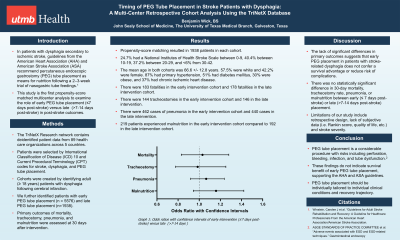Monday Poster Session
Category: Interventional Endoscopy
P2765 - Timing of PEG Tube Placement in Stroke Patients with Dysphagia: A Multi-Center Retrospective Cohort Analysis Using the TriNetX Database
Monday, October 28, 2024
10:30 AM - 4:00 PM ET
Location: Exhibit Hall E

Has Audio
- BW
Benjamin Wick, BS
University of Texas Medical Branch, John Sealy School of Medicine
Galveston, TX
Presenting Author(s)
Benjamin Wick, BS
University of Texas Medical Branch, John Sealy School of Medicine, Galveston, TX
Introduction: Placement of a percutaneous endoscopy gastronomy (PEG) tube is a common intervention for stroke patients who experience dysphagia. While 2011 ASGE guidelines recommend PEG tube placement after a 2-3 week trial of nasoenteric feeding, placement rates vary widely among institutions. This study is the first propensity-score matched multi-center retrospective cohort analysis of patients undergoing early (≤ 7 days post-stroke) versus late ( >7 days post-stroke) PEG tube placement for dysphagia utilizing the TriNetX database, a global research network.
Methods: The TriNetX Research network contains deidentified patient data from 89 health care organizations across 5 countries. Patients were selected by International Classification of Disease (ICD) 10 and Current Procedural Terminology (CPT) codes for stoke, dysphagia, and PEG tube placement. Primary outcomes of mortality, tracheostomy, pneumonia, and malnutrition were assessed at 30 days after intervention. Cohorts were propensity-score matched by ICD-10 and CPT codes for age, race, BMI, various comorbidities, as well as National Institutes of Health Stroke Scale (NIHSS) score.
Results: Propensity-score matching resulted in 1938 patients in each cohort. 24.7% had a NIHSS between 0-9, 40.4% between 10-19, 37.2% between 20-29, and < 6% from 30-42. The mean age in both cohorts was 66.6 +/- 12.8 years. 57.5% were white and 42.2% were female. There were 183 fatalities in the early intervention cohort and 178 fatalities in the late intervention cohort (OR = 1.031, [0.830-1.280]). There were 144 tracheostomies in the early intervention cohort and 146 in the late intervention cohort (OR = 0.985, [0.776-1.252]). There were 462 cases of pneumonia in the early intervention cohort and 440 cases in the late intervention (OR = [0.918, 1.237]. 219 patients experienced malnutrition in the early intervention cohort compared to 192 in the late intervention cohort (OR = 1.159 [0.944,1.422])
Discussion: The lack of significant differences in primary outcomes suggests that early PEG placement in patients with stroke-related dysphagia does not confer a survival advantage or reduce risk of complications. There was no statistically significant difference in 30-day mortality, tracheostomy rate, pneumonia, or malnutrition between early (≤ 7 days post-stroke) or late ( >7-14 days post-stroke) placement. These findings support the 2011 ASGE guidelines and indicate that PEG placement should be individually tailored to individual clinical conditions and recovery trajectory.
Note: The table for this abstract can be viewed in the ePoster Gallery section of the ACG 2024 ePoster Site or in The American Journal of Gastroenterology's abstract supplement issue, both of which will be available starting October 27, 2024.
Disclosures:
Benjamin Wick, BS. P2765 - Timing of PEG Tube Placement in Stroke Patients with Dysphagia: A Multi-Center Retrospective Cohort Analysis Using the TriNetX Database, ACG 2024 Annual Scientific Meeting Abstracts. Philadelphia, PA: American College of Gastroenterology.
University of Texas Medical Branch, John Sealy School of Medicine, Galveston, TX
Introduction: Placement of a percutaneous endoscopy gastronomy (PEG) tube is a common intervention for stroke patients who experience dysphagia. While 2011 ASGE guidelines recommend PEG tube placement after a 2-3 week trial of nasoenteric feeding, placement rates vary widely among institutions. This study is the first propensity-score matched multi-center retrospective cohort analysis of patients undergoing early (≤ 7 days post-stroke) versus late ( >7 days post-stroke) PEG tube placement for dysphagia utilizing the TriNetX database, a global research network.
Methods: The TriNetX Research network contains deidentified patient data from 89 health care organizations across 5 countries. Patients were selected by International Classification of Disease (ICD) 10 and Current Procedural Terminology (CPT) codes for stoke, dysphagia, and PEG tube placement. Primary outcomes of mortality, tracheostomy, pneumonia, and malnutrition were assessed at 30 days after intervention. Cohorts were propensity-score matched by ICD-10 and CPT codes for age, race, BMI, various comorbidities, as well as National Institutes of Health Stroke Scale (NIHSS) score.
Results: Propensity-score matching resulted in 1938 patients in each cohort. 24.7% had a NIHSS between 0-9, 40.4% between 10-19, 37.2% between 20-29, and < 6% from 30-42. The mean age in both cohorts was 66.6 +/- 12.8 years. 57.5% were white and 42.2% were female. There were 183 fatalities in the early intervention cohort and 178 fatalities in the late intervention cohort (OR = 1.031, [0.830-1.280]). There were 144 tracheostomies in the early intervention cohort and 146 in the late intervention cohort (OR = 0.985, [0.776-1.252]). There were 462 cases of pneumonia in the early intervention cohort and 440 cases in the late intervention (OR = [0.918, 1.237]. 219 patients experienced malnutrition in the early intervention cohort compared to 192 in the late intervention cohort (OR = 1.159 [0.944,1.422])
Discussion: The lack of significant differences in primary outcomes suggests that early PEG placement in patients with stroke-related dysphagia does not confer a survival advantage or reduce risk of complications. There was no statistically significant difference in 30-day mortality, tracheostomy rate, pneumonia, or malnutrition between early (≤ 7 days post-stroke) or late ( >7-14 days post-stroke) placement. These findings support the 2011 ASGE guidelines and indicate that PEG placement should be individually tailored to individual clinical conditions and recovery trajectory.
Note: The table for this abstract can be viewed in the ePoster Gallery section of the ACG 2024 ePoster Site or in The American Journal of Gastroenterology's abstract supplement issue, both of which will be available starting October 27, 2024.
Disclosures:
Benjamin Wick indicated no relevant financial relationships.
Benjamin Wick, BS. P2765 - Timing of PEG Tube Placement in Stroke Patients with Dysphagia: A Multi-Center Retrospective Cohort Analysis Using the TriNetX Database, ACG 2024 Annual Scientific Meeting Abstracts. Philadelphia, PA: American College of Gastroenterology.
